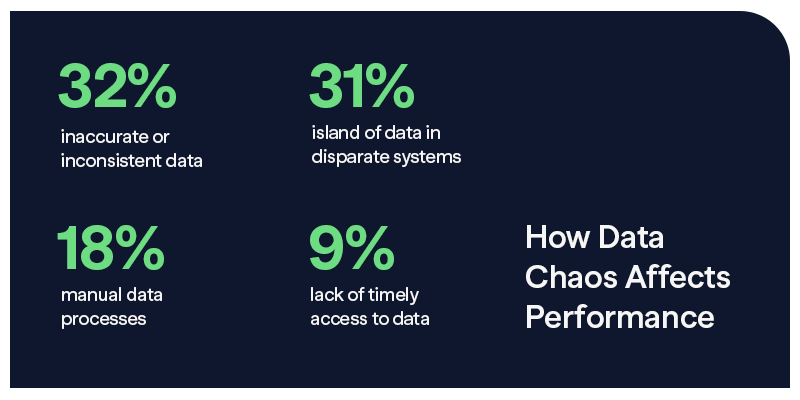Key Takeaways
- Financial leaders are increasingly accountable for digital initiatives alongside IT leaders.
- Data chaos and IT risks impact more than technology — they influence organizational performance and financial health.
- When finance and IT partner, organizations gain the visibility, control, and confidence needed to move faster and make smarter decisions.
The role of finance is shifting. As digital strategies increasingly impact financial health and long-term growth, CFOs and finance teams are stepping into a more strategic, cross-functional role. Whereas leaders have traditionally focused on financial reporting, budgeting, and compliance, today’s finance teams are helping shape strategy, adopt technologies, assess risk, and drive digital transformation. You’re not just tracking performance anymore — you’re influencing it.
Recent polling shows digital transformation is no longer solely owned by IT. Finance leaders now share nearly equal responsibility for moving these initiatives forward.
Today, success as a financial leader depends on more than business acumen. It requires visibility: the ability to work from clean, consistent, and connected data. Discover how inefficiently managed data and IT can impact the entire organization, so you can adapt to meet the demands of the digital age.
How Data Chaos Affects Performance
When data is messy, incomplete, or scattered across disconnected systems, it becomes more difficult to run your organization. In a recent poll, we asked participants to identify the biggest ways in which data chaos has affected their organizations. The most common responses included:

Data chaos isn’t just an IT issue — it’s a performance issue. Inaccurate or inconsistent data can obscure the true state of the organization, leading to poor decision-making as leaders rely on flawed information to guide their strategies. Disparate systems create silos, making it difficult to clearly see what’s happening across departments. This lack of visibility into all aspects of the organization makes it difficult to identify issues and opportunities promptly.
Manual data processes make matters worse. They are slow, error-prone, and costly. And when critical data isn’t accessible in real time, organizations struggle to act quickly and strategically.
Here’s why it matters: The quality, quantity, and accessibility of an organization’s data impact its ability to stay competitive, adopt AI, and drive innovation.
By addressing data chaos and its impacts on visibility, you can equip teams with the clarity and insight they need to move faster, make smarter decisions, and drive meaningful results.
Setting the Stakes: IT Risk and Its Impacts
In the current digitally driven business environment, the risks associated with technology go beyond the confines of the IT department. These risks can be:
Technological:
Technological risk involves potential failures or vulnerabilities within an organization’s IT infrastructure. This can include hardware malfunctions, software bugs, cybersecurity breaches, and data loss. As digital modernization accelerates and the reliance on technology increases, managing these risks is key to staying resilient.
Financial:
IT-related issues can result in financial losses, including costs associated with data breaches, regulatory fines, legal liabilities, and the economic impact of operational disruptions. Data breaches, privacy violations, and service outages also erode customer trust and confidence.
Operational:
Potential operational disruptions due to IT failures can include system outages, process inefficiencies, and the inability to access critical data. Such disruptions can lead to significant productivity losses and affect the organization’s ability to serve its customers effectively.
Dig Deeper: Watch as Jon Ault, Principal at Eide Bailly, discusses the risks associated with cybersecurity.
Given the significant technological, financial, operational, and reputational stakes, it is essential for CFOs to be actively involved in managing IT risks.
The CFO as a Strategic Partner in Technology Planning
Technology leaders bring invaluable expertise to any organization, leveraging cutting-edge tools to drive efficiency and growth. Financial leaders, on the other hand, excel at optimizing the bottom line and steering the organization towards sustained growth. When the two join forces, organizations can harness the full potential of technology to drive financial success.
Involving financial leaders in technology planning is crucial for several reasons:
Holistic Perspective:
CFOs understand the financial implications of digital initiatives and can balance short-term costs with long-term benefits. CTOs bring a deep understanding of technology trends and innovations, ensuring that investments are not only financially sustainable but also in line with the latest advancements. Together, they ensure that technology investments drive both innovation and financial stability.
Cross-Functional Collaboration:
By working closely with IT, operations, marketing, and other departments, financial leaders can ensure that digital initiatives are integrated seamlessly across the organization. This partnership enhances the overall effectiveness of technology projects, ensuring they meet both operational and strategic goals.
Financial Discipline:
CFOs instill financial discipline in technology planning. They emphasize the importance of cost control, ROI analysis, and value creation, while CTOs ensure that technology solutions are efficient, scalable, and capable of delivering the expected returns. This disciplined approach helps prevent overspending and ensures that digital initiatives deliver tangible benefits.
Strategic Decision-Making:
Strong analytical skills and financial acumen enable financial leaders to evaluate complex technology proposals and make informed choices. CTOs contribute by providing insights into the technical feasibility and potential impact of these proposals. This strategic partnership is essential for navigating the rapidly changing digital landscape, ensuring that decisions are both financially sound and technologically forward-thinking.
Bridging Finance and IT
When finance and IT work together, organizations can make smarter technology investments, strengthen risk management, and create long-term value. At Eide Bailly, our advisors help connect these functions, so you gain clarity, reduce complexity, and stay competitive in a fast-changing digital landscape.
Webinar: Finance’s Role in Your Data Goals and IT Risk
Digital
Who We Are
Eide Bailly is a CPA firm bringing practical expertise in tax, audit, and advisory to help you perform, protect, and prosper with confidence.




